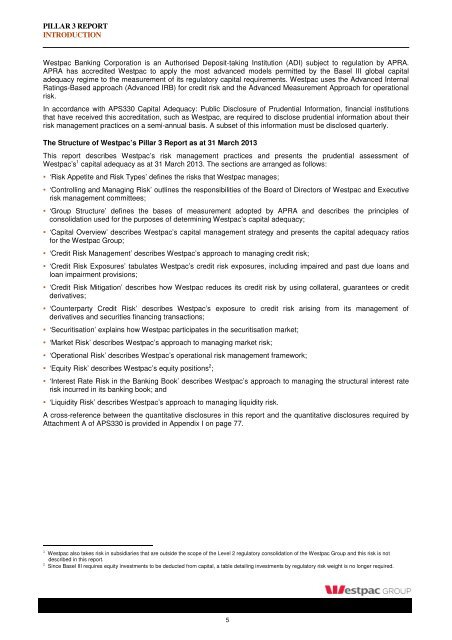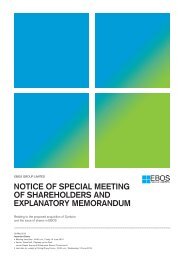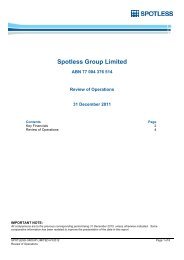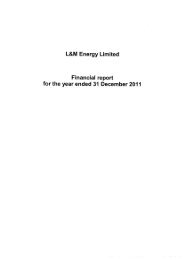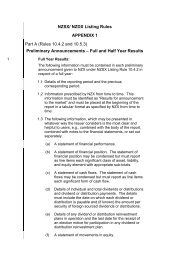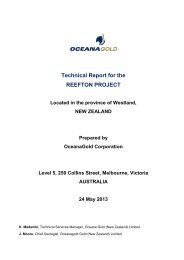Westpac Group Pillar 3 Report March 2013 - Iguana IR Sites
Westpac Group Pillar 3 Report March 2013 - Iguana IR Sites
Westpac Group Pillar 3 Report March 2013 - Iguana IR Sites
Create successful ePaper yourself
Turn your PDF publications into a flip-book with our unique Google optimized e-Paper software.
PILLAR 3 REPORT<br />
INTRODUCTION<br />
<strong>Westpac</strong> Banking Corporation is an Authorised Deposit-taking Institution (ADI) subject to regulation by APRA.<br />
APRA has accredited <strong>Westpac</strong> to apply the most advanced models permitted by the Basel III global capital<br />
adequacy regime to the measurement of its regulatory capital requirements. <strong>Westpac</strong> uses the Advanced Internal<br />
Ratings-Based approach (Advanced <strong>IR</strong>B) for credit risk and the Advanced Measurement Approach for operational<br />
risk.<br />
In accordance with APS330 Capital Adequacy: Public Disclosure of Prudential Information, financial institutions<br />
that have received this accreditation, such as <strong>Westpac</strong>, are required to disclose prudential information about their<br />
risk management practices on a semi-annual basis. A subset of this information must be disclosed quarterly.<br />
The Structure of <strong>Westpac</strong>’s <strong>Pillar</strong> 3 <strong>Report</strong> as at 31 <strong>March</strong> <strong>2013</strong><br />
This report describes <strong>Westpac</strong>’s risk management practices and presents the prudential assessment of<br />
<strong>Westpac</strong>’s 1 capital adequacy as at 31 <strong>March</strong> <strong>2013</strong>. The sections are arranged as follows:<br />
‘Risk Appetite and Risk Types’ defines the risks that <strong>Westpac</strong> manages;<br />
‘Controlling and Managing Risk’ outlines the responsibilities of the Board of Directors of <strong>Westpac</strong> and Executive<br />
risk management committees;<br />
‘<strong>Group</strong> Structure’ defines the bases of measurement adopted by APRA and describes the principles of<br />
consolidation used for the purposes of determining <strong>Westpac</strong>’s capital adequacy;<br />
‘Capital Overview’ describes <strong>Westpac</strong>’s capital management strategy and presents the capital adequacy ratios<br />
for the <strong>Westpac</strong> <strong>Group</strong>;<br />
‘Credit Risk Management’ describes <strong>Westpac</strong>’s approach to managing credit risk;<br />
‘Credit Risk Exposures’ tabulates <strong>Westpac</strong>’s credit risk exposures, including impaired and past due loans and<br />
loan impairment provisions;<br />
‘Credit Risk Mitigation’ describes how <strong>Westpac</strong> reduces its credit risk by using collateral, guarantees or credit<br />
derivatives;<br />
‘Counterparty Credit Risk’ describes <strong>Westpac</strong>’s exposure to credit risk arising from its management of<br />
derivatives and securities financing transactions;<br />
‘Securitisation’ explains how <strong>Westpac</strong> participates in the securitisation market;<br />
‘Market Risk’ describes <strong>Westpac</strong>’s approach to managing market risk;<br />
‘Operational Risk’ describes <strong>Westpac</strong>’s operational risk management framework;<br />
‘Equity Risk’ describes <strong>Westpac</strong>’s equity positions 2 ;<br />
‘Interest Rate Risk in the Banking Book’ describes <strong>Westpac</strong>’s approach to managing the structural interest rate<br />
risk incurred in its banking book; and<br />
‘Liquidity Risk’ describes <strong>Westpac</strong>’s approach to managing liquidity risk.<br />
A cross-reference between the quantitative disclosures in this report and the quantitative disclosures required by<br />
Attachment A of APS330 is provided in Appendix I on page 77.<br />
1 <strong>Westpac</strong> also takes risk in subsidiaries that are outside the scope of the Level 2 regulatory consolidation of the <strong>Westpac</strong> <strong>Group</strong> and this risk is not<br />
described in this report.<br />
2 Since Basel III requires equity investments to be deducted from capital, a table detailing investments by regulatory risk weight is no longer required.<br />
5


